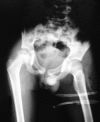Primary obturator internus and obturator externus pyomyositis
- PMID: 23826443
- PMCID: PMC3700476
- DOI: 10.12659/AJCR.883871
Primary obturator internus and obturator externus pyomyositis
Abstract
Background: Pyomyositis is a rare condition in immune competent patients and is usually seen in tropical countries. Pyomyositis of obturator muscles in particular is an extremely rare condition, which causes hip pain and mimics septic arthritis.
Case report: This is a case report of a 9-year-old boy without an underlying disease or a compromised immune system, who presented with knee pain that progressed to hip pain and inability to bear weight. He was diagnosed initially with septic arthritis of the hip and underwent unnecessary hip exploration surgery. Magnetic resonance imaging scan was performed postoperatively and showed pyomyositis of obturator internus and obturator externus muscles. He was managed medically and had a good outcome.
Conclusions: A greater awareness of this emergency condition is necessary to prevent misdiagnosis, unnecessary surgical intervention, and to avoid the devastating possible complications of delayed diagnosis.
Keywords: obturator externus; obturator internus; obturator pyomyositis; primary pyomyositis; septic arthritis.
Figures



References
-
- Orlicek SL, Abramson JS, Woods CR, Givner LB. Obturator internus muscle abscess in children. J Pediatr Orthop. 2001;21(6):744–48. - PubMed
-
- Bansal M, Bhaliak V, Bruce CE. Obturator internus muscle abscess in a child: a case report. J Pediatr Orthop B. 2008;17(5):223–24. - PubMed
-
- King RJ, Laugharne D, Kerslake RW, Holdsworth BJ. Primary obturator pyomyositis: a diagnostic challenge. J Bone Joint Surg Br. 2003;85-B(6):895–98. - PubMed
-
- Viani RM, Bromberg K, Bradley JS. Obturator internus muscle abscess in children: report of seven cases and review. Clin Infect Dis. 1999;28(1):117–22. - PubMed
LinkOut - more resources
Full Text Sources
Other Literature Sources
